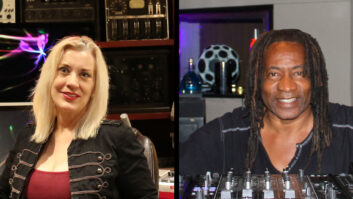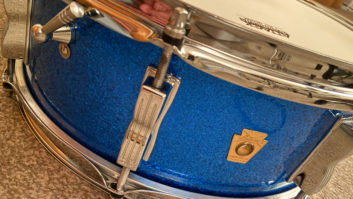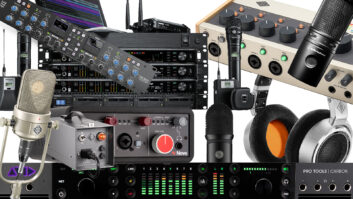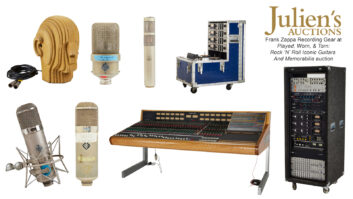
How can you keep from smiling? It farts, groans, weedles and screams as it’s being played, with hands moving erratically around its metal antennae. I keep the crazy thing hidden in the equipment locker at the studio and only reveal its presence when I know we have lots of time to kill. That’s when I’ll pull out the Theremin. It’s always good for a laugh and maybe, just maybe, we’ll get a keeper track. For the most part, it is best as a bonding element and a great video opportunity that everyone can participate in as no one needs any particular advance training to play one. In the world of weird, obscure musical instruments, the Theremin is king.
The sound of the Theremin is unmistakable. Its otherworldly warbling tone is heard in many classic B-grade sci-fi flicks from the 1950s. As much as it is a novelty for us in recording sessions, the Theremin’s development and history are profound in the field of electronic music. In fact, you can consider this invention to be the original electronic instrument!
THE BEGINNINGS
Russian inventor and cellist Léon Theremin (originally known as Lev Termen) designed several early electronic instruments, microphones and video devices during his long life. He is best known as the inventor of the Theremin, which he patented in 1928. It is a device that generates an electronic tone; the frequency and volume are controlled by holding your hands close to (but not touching) antennae on the sides of the unit. The closer your hand is to the first antenna, the higher the pitch generated. The closer your hand is to the second antenna, the louder the tone gets. By wiggling your hand as you control the note, you can get a bowed vibrato tone that’s similar to a violin or cello, just a lot more alien-sounding—thus its popularity as the spooky sound featured in 1950s movie thrillers such as The Day the Earth Stood Still and The Thing (From Another Planet).

Angelo Moore onstage with Fishbone, playing his psychedelic Etherwave Moog
In the world of rock music, the Theremin has been used in several classic recordings including Led Zeppelin’s “Whole Lotta Love” and the Beach Boys’ Pet Sounds. You’ll hear Jimmy Page wailing away on a Theremin in the film The Song Remains the Same. There are also several current masters of this instrument in rock music; one of the best I’ve recorded is Angelo Moore from the band Fishbone. He sometimes uses an older wooden vacuum tube model patched into an array of guitar pedals and a guitar amp to rev up its sound. His spastic, wild waving of hands while playing the Theremin just adds to the excitement of his live performances. Robert Wheeler from the band Pere Ubu and Dave Gibney from Los Angeles’ Chingalera are other great, but perhaps obscure, Thereminists.
Among many of his inventions, Theremin also developed the “rhythmicon,” which was the first drum machine, and the “terpsitone,” a device that translates a dancer’s movements into electronic musical notes. The terpsitone was seemingly a larger version of the Theremin, using a dancer’s entire body to play the thing instead of just the hands, and it was completely uncontrollable! Theremin’s inventions caused a sensation in the world of avant-garde music in the 1930s, when he became somewhat of a celebrity in America. He paid dearly for his ingenuity and his notoriety when he suddenly disappeared in the late ’30s; it was rumored that he was taken by the KGB to a Soviet work camp “laboratory” in Siberia. He was not to return to the U.S. for the next 30 years.

The inventor and his instrument
There are conflicting reports on what exactly had happened to Theremin during World War II and the ensuing Cold War. It is known that he was “rehabilitated” by the KGB and released in 1956, when he was awarded the Stalin Prize for inventing an espionage device called the “buran,” the precursor to the modern laser microphone. The buran used infrared light reflections to detect and translate sound vibrations from distant glass surfaces and was used as a spying device against the U.S. during the Cold War. Theremin had built friendships with Americans who loved his electronic instruments and music, yet he was obliged to support his homeland by providing his scientific inventions to the Soviet government. This double alliance eventually tore Theremin’s world apart. After working for the KGB, Theremin had a lab at the Moscow Conservatory of Music for 10 years where he taught and built Theremins, electronic cellos and terpsitones. A visiting correspondent discovered him there, and when a New York Times article was published about the Russian inventor, the managing director of the Conservatory said, “The people don’t need electronic music. Electricity is for killing traitors in the electric chair.” He then fired Professor Theremin, closed his laboratory and had his instruments destroyed.

The completely uncontrollable terpsitone
Theremin eventually returned to the United States in 1991. He died in Moscow in 1993 at the age of 97. His designs have been rebuilt by enthusiasts over the years, including the late Robert Moog, pioneer of the modern synthesizer. Theremin was also immortalized in the 1994 movie of his life: Theremin—An Electronic Odyssey, further reviving interest in the inventor and his instruments.
BACK TO THE PRESENT
After seeing a Theremin instrument being used in a session, I purchased a prebuilt kit model developed by Moog and sold by Big Briar (and it’s actually signed by Mr. Moog!). Modern Thereminists enjoy using “concert”-quality instruments by several manufacturers today, including Moog Music, Theremaniacs, Burns and Harrison Instruments. The “Ethervox” is Moog Music’s contribution as the world’s first MIDI Theremin. More recently, Theremin technology has been used to create a new generation of guitar effect controllers. The Probe from Z.Vex Pedals is an amazing device for your guitar, controlled by the proximity of your foot to the pedal. Z.Vex now makes several varieties of the Probe, including a Fuzz Probe, Tremolo Probe and Wah Probe.
Theremin will forever be a part of electronic music’s colorful landscape, and should be recognized for innovation and creativity in the field of music technology. I keep my Theremin in the equipment locker at the studio and look forward to every chance I can bring it out. If you have a Theremin in your closet, make sure all your foundation tracking has been done, because unless your performer is a virtuoso, this solo may take awhile. It can be a heck of a lot of fun, but can also eat up all your precious tracking time!
Sylvia Massy is the unconventional producer and engineer of artists including Tool, System of a Down, Johnny Cash, Red Hot Chili Peppers, Tom Petty and Prince. She is a member of the NARAS P&E Wing Steering Committee and Advisory Boards, and is a resident producer at RadioStar Studios in Weed, Calif.







